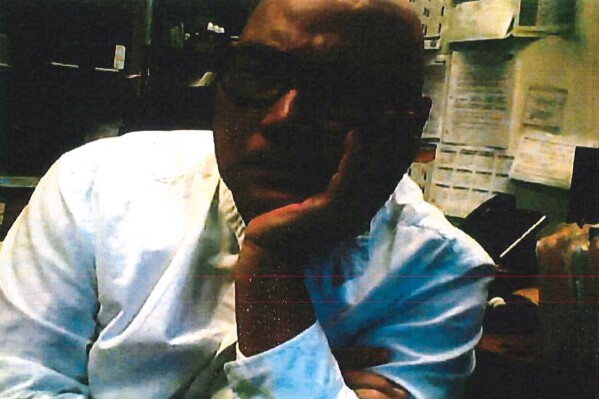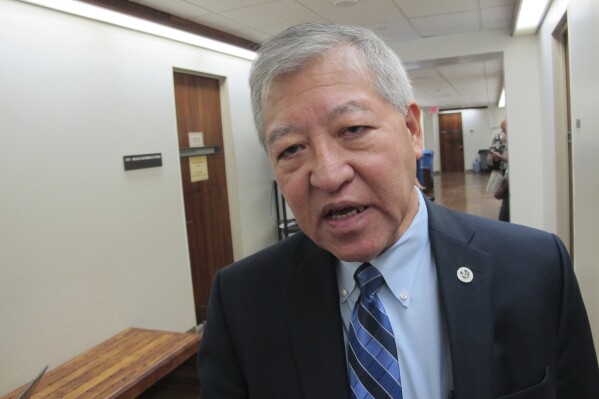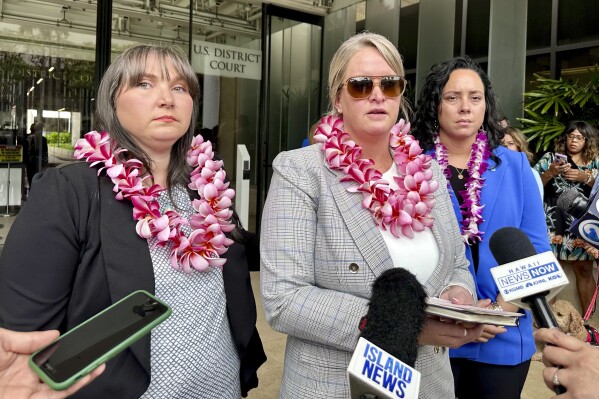The backlog of Honolulu building permits is taking a toll on city revenue
HONOLULU (AP) — The new Raising Cane’s restaurant in Pearl City was a financial win for the city.
Before the eatery was built, the owners were paying about $62,000 in city property taxes for what was then an empty lot. By the time the restaurant opened in 2022, the property’s value had jumped by $1.5 million, and the tax bill increased to $82,000.
But the county didn’t get to collect that extra $20,000 right away. After a permit application was submitted in May 2020, Honolulu’s Department of Planning and Permitting took a year and seven months to approve it. The increased tax bill didn’t go into effect until 2023.
Had the plans been approved and construction started by the October 2020 tax assessment deadline, the city would be up to $40,000 richer today.
As Honolulu’s permitting department struggles to keep up with its workload, there is a growing gap between the number of applications DPP receives and the number of permits it issues. The mounting backlog is a major frustration for applicants, and a Civil Beat analysis indicates it is also hurting the city itself.
Each permit issued in fiscal year 2023 represented an average of more than $220,000 in taxable construction work and over $1,400 in building permit fees, according to a Civil Beat review of county permitting statistics. The thousands of others left to wait are worth millions of dollars in city revenue.



In the 2023 fiscal year alone, Honolulu received close to 20,000 permit applications but issued fewer than 15,000. The difference — carried over into the following year — represents an average of more than $1 billion in taxable construction work and nearly $7 million in building permit fees.
In some cases, like that of Raising Cane’s, the city is missing out on a year or more of increased tax revenue from properties whose value is set to rise due to new construction or renovations. Honolulu property tax rates vary from .35% for owner-occupied homes to 1.39% for hotels and resorts.
While the city may tax that new construction and collect those fees in the future, the delays mean it’s unable to invest those earnings in services today.
“That’s just basic economics,” said Beth Giesting, a former director of the Hawaii Budget and Policy Center. “A dollar you can get today is worth more than one you can get next year or five years from now.”
While the number of applications DPP receives hasn’t changed much over the years — it’s usually around 15,000 per year — the department’s ability to process them in a timely manner has tanked, city data shows.
A department that used to be staffed by knowledgeable, longtime employees now struggles with a constant turnover of workers with little experience reviewing permits. And it didn’t help that several seasoned DPP officials were busted in a bribery scheme in 2021 that sent six people to prison. Making matters worse, DPP has relied on antiquated computer systems, a lack of standard operating procedures and what the department says is a decline in the quality of plans it receives from applicants.
While the department says it is working to address all of these challenges, the confluence of factors have nevertheless resulted in a backlog that has built upon itself year after year and puts projects big and small on pause – a loss for property owners and for the city.
The sooner construction starts, the sooner the city can tax it, even if the work isn’t completed by the county’s Oct. 1 property tax assessment deadline, according to Honolulu budget director Andy Kawano. If the work is only 50% done, for example, the tax bill will factor that in, he said. When a project is delayed, so is the increased assessment.
Take the case of a newly constructed home on Uhu Street in Kapolei. The permit application was submitted in January 2021 but wasn’t approved until a year later, according to city permitting records. After the home was built, the property tax bill more than doubled, property records show, going from about $2,100 to $5,300.
If the permit had been issued quickly and construction had begun by the tax assessment deadline in October 2021, the city could have captured at least part of that tax bump in 2022. Instead, it didn’t collect an increase until 2023.
It’s hard to say whether any particular delay was DPP’s fault. Public records don’t indicate whether specific projects were stalled due to hold-ups on DPP’s end or that of the applicant.
Calculating total city-wide revenue losses due to permit delays is also difficult due to the vast number of variables involved. But it’s clear that the growing delays at the permitting office are taking a chunk out of the county’s potential earnings, according to Dylan Moore, a University of Hawaii economist who reviewed Civil Beat’s findings.
“It looks like a failure of government policy,” said Moore, whose work focuses on public finance.
The city says it is working to speed up permit approvals with the aim of efficiency, not necessarily to bring in more money.
“That’s not our mission, to create revenue,” DPP Director Dawn Takeuchi Apuna said. “We certainly want to receive property taxes, and people want to use their properties to the fullest potential under a permit. We’re focused on fixing the process.”
Honolulu Managing Director Mike Formby acknowledged that DPP’s delays could amount to county revenue losses, at least for residential projects.
He said it’s a murkier picture for commercial jobs, which can face major construction delays unrelated to DPP, including challenges with financing or delays on approvals by state agencies.
The quality of the permit applications themselves can play a major role in timing, too. Building plans that are not up to code can get multiple rounds of comments that delay the permitting process.
“It should not reflect all on the city or DPP,” Formby said. “To the extent that we are responsible by being inefficient, we’re accountable for that. And that’s what this administration has committed to fix with systemic change.”
Even when a job is permitted by DPP, it may not immediately be built — and taxed, he noted.
“There’s always a lag,” he said. “We’re actually getting the benefit of things that were permitted under prior administrations because now they’re in construction.”
Honolulu City Councilman Tyler Dos-Santos Tam said the numbers underscore the need to get DPP up to speed once and for all. If the city could collect even 10% or 20% of the money left on the table every year, the councilman said it could provide better services to residents.
“We always get told every day, ‘You know, this would be nice, but we can’t afford it right now,’” he said. “If the department gets through the permit backlog and issues a bunch of new permits, they collect the fees and they can put that into further investments into the department.”
The administration has blamed the permitting delays in part on understaffing fueled by low wages for permit reviewers. DPP’s vacancy rate has hovered around 25%.
Honolulu Mayor Rick Blangiardi said the city is looking into raising wages but doesn’t currently have the means to do it.
And at a budget hearing in March, Takeuchi Apuna said her department is “under-resourced, for all the things that we need to do.”
But the numbers suggest that directing more money to DPP would yield a positive return on investment, particularly for staff salaries, according to Moore. Starting pay for a plans examiner is less than $40,000 — a level that qualifies those employees for low-income housing.
This year, the Blangiardi administration is proposing spending only 1% of the city budget, which mostly comes from the general fund, on the permitting department. The city could do better, Moore said.
“If you doubled people’s wages and hired enough people to clear the backlog, it would probably still pay for itself with just the permit fees alone,” Moore said. “And the permit fees, I think, are really just the tip of the iceberg.”
DPP’s delays also likely hurt state revenues, Moore said. When construction jobs are stalled because of permit delays, that amounts to a lag in the collection of state income taxes and general excise taxes.
And then there are losses from people who choose to bypass Honolulu’s slow permitting process altogether and build illegally. For unpermitted jobs, the city misses out on an unknown amount of building permit fees and property tax revenue, according to Kawano.
Government revenue losses due to slow permitting have been a topic of concern on the mainland for years. A representative of the Texas-based Real Estate Council estimated in 2022 that the city of Dallas alone loses $9 million in property tax revenue every three months due to permitting delays, although the city disputed that total.
In 2005, an American Institute of Architects-funded report by PricewaterhouseCoopers found that speeding up permitting can permanently boost local government revenues, including a 16.5% bump over the first five years.
“While achieving a reduction in permitting times is not costless (i.e., it may require one-time costs for implementing systems changes and potentially ongoing costs for the hiring of additional staff), these changes have the potential to be self financing,” the report states.
“The additional tax collections from more efficient permit processes could offset the investment made to achieve the improvements.”
If permitting were speedier, increased revenue could be spent on the city’s other priorities, too, Moore said, from public safety to parks.
“That’s a free lunch,” he said. “That’s something you should do tomorrow.”
Councilman Dos Santos-Tam acknowledged that revenue is not DPP’s objective, but he wonders if it should be at least one of the department’s goals. Specifically, he’d like to see the department be financially self-sustaining as a way to motivate the department to improve its services.
As of now, whatever money DPP generates goes into the county’s general fund for potential use by all city departments. And every year, DPP has to ask the mayor and the City Council for money to fund its operations.
The councilman is proposing a special fund that would require all DPP revenues to be spent exclusively on DPP itself. The change would force the city to invest in the department and would create an incentive for the department to boost its performance, he said.
“I want to create a culture where they’re eager to go out and process fees faster, and they get to reap the rewards as a department,” he said.
Bill 20 is pending at the council but has faced some pushback. The city budget department and some council members say special funds are overly restrictive, and some community members are concerned that the proposed revenue structure could encourage overzealous enforcement of building rules.
Formby is philosophically opposed to the concept.
“When it’s all in the general fund, it’s based upon on the priorities of the people, which is what we’re actually supposed to be a manifestation of — public safety, affordable housing, homelessness,” he said.
“If you start down that path of saying to every department, you basically spend what you generate, the system doesn’t work very well.”
Takeuchi Apuna has also noted that if there were a downturn in the construction industry, a self-funded DPP could find itself unable to make payroll. The councilman said in that circumstance, the council would step in to provide additional funding.
Whatever the mechanism, DPP needs to improve soon, Dos Santos-Tam said.
“These kinds of changes need to actually happen faster. Less talk, more action,” he said. “That’s not to say they’re not doing anything, but, you know, we can always do more.”
Takeuchi Apuna said she is focused on turning her department around, which will in turn increase collections from fees and taxes.
“We just have to fix what we’re doing,” she said. “I think the ultimate goal is to be timely in our permits, and that will more timely allow the city to receive revenues from those projects.”
The challenge is reversing a trend of delays that have mounted over the course of at least 20 years, city data show.
Two decades ago, residential permits took an average of less than two months to issue. Last year, they took an average of nine months. Commercial jobs 20 years ago could get the city’s blessing in less than three months, on average. By 2023, the wait time skyrocketed to more than 14 months.
The wait times have increased particularly sharply in the last three years for both commercial and residential jobs and have hit unprecedented levels, according to city data.
The Blangiardi administration is investing millions of dollars in new technology, formulating new standard operating procedures with the help of outside consultants and instituting more competitive salaries for engineers who work on commercial projects.
During his state of the city address in March, Blangiardi pledged that within a year, DPP’s average residential review time will take no longer than a month and commercial reviews will not exceed six months.
The city has made progress reducing the time for preliminary reviews known as “prescreening” from several months to several days. But the total permit review time remains stubbornly slow.
In a report to the Honolulu City Council in May, the department acknowledged that wait times for commercial permits had not improved much since its last update, and in the case of residential plans are slower than they were eight months ago.
The administration says it is laying a foundation for structural changes. The adjustments require staff attention and resources in the short term but should have a lasting impact in the long run, officials say.
“Building permits are for health and safety, so of course we would like to have a shorter timeframe in which to review those,” Takeuchi Apuna said. “But that is important for us, to ensure we review it properly.”
___
This story was originally published by Honolulu Civil Beat and distributed through a partnership with The Associated Press.
Disclaimer: The copyright of this article belongs to the original author. Reposting this article is solely for the purpose of information dissemination and does not constitute any investment advice. If there is any infringement, please contact us immediately. We will make corrections or deletions as necessary. Thank you.




